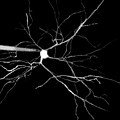Watching a living brain in the act of seeing -- with single-synapse resolution
New method reveals how individual nerve cells process visual input

Dendrites of a nerve cell in brain appear like branches of a tree. Left: A patch clamp pipette injects fluorescent dye into the cell.
28.04.2010, Press releases
Pioneering a novel microscopy method, neuroscientist Arthur Konnerth and colleagues from the Technische Universität München (TUM) have shown that individual neurons carry out significant aspects of sensory processing: specifically, in this case, determining which direction an object in the field of view is moving. Their method makes it possible for the first time to observe individual synapses, nerve contact sites that are just one micrometer in size, on a single neuron in a living mammalian brain. Focusing on neurons known to play a role in processing visual signals related to movement, Konnerth's team discovered that an individual neuron integrates inputs it receives via many synapses at once into a single output signal -- a decision, in essence, made by a single nerve cell. The scientists report these results in the latest issue of the journal Nature. Looking ahead, they say their method opens a new avenue for exploration of how learning functions at the level of the individual neuron.
When light falls on the retina of the human eye,
it hits 126 million sensory cells, which transform it into electrical signals.
Even the smallest unit of light, a photon, can stimulate one of these sensory
cells. As a result, enormous amounts of data have to be processed for us to be
able to see. While the processing of visual data starts in the retina, the
finished image only arises in the brain or, to be more precise, in the visual
cortex at the back of the cerebrum. Scientists working with Arthur Konnerth --
neurophysiologist and professor at TUM and Carl von Linde Senior Fellow at the
TUM Institute for Advanced Study -- are interested in a certain kind of neuron
in the visual cortex that fires electrical signals when an object moves in
front of our eyes -- or the eyes of a mouse.
When a mouse is shown a horizontal bar pattern in
motion, specific neurons in its visual cortex consistently respond, depending
on whether the movement is from bottom to top or from right to left. The impulse
response pattern of these “orientation” neurons is already well known. What was
not previously known, however, is what the input signal looks like in detail. This
was not easy to establish, as each of the neurons has a whole tree of tiny,
branched antennae, known as dendrites, at which hundreds of other neurons "dock"
with their synapses.
The effort has already rewarded the team with a
discovery. They found that in response to differently oriented motions of a bar
pattern in the mouse's field of vision, an individual orientation neuron
receives input signals from a number of differently oriented nerve cells in its
network of connections but sends only one kind of output signal. "And
this," Konnerth says, "is where things get really exciting." The
orientation neuron only sends output signals when, for example, the bar pattern
moves from bottom to top. Evidently the neuron weighs the various input signals
against each other and thus reduces the glut of incoming data to the most
essential information needed for clear perception of motion.
Picture:
http://mediatum2.ub.tum.de/node?id=977436
Original Nature publication:
Dendritic organization of sensory input to cortical neurons in vivo
Hongbo Jia, Nathalie L. Rochefort, Xiaowei Chen, Arthur Konnerth DOI: 10.1038/nature08947
This work was supported by grants from Deutsche Forschungsgemeinschaft (DFG) and Friedrich-Schiedel-Stiftung.
Contact:
Prof. Arthur Konnerth
TUM Institute for Advanced Study (IAS) Fellow (1)
(IAS Carl von Linde Senior Fellow)
Director of Institute of Neuroscience
Technische Universität München - Technical
University of Munich
Tel. 089 4140
3351
office.konnerth@lrz.tum.de
www.ifn.me.tum.de
Kontakt: presse@tum.de
More Information
| 100428_SehenGehirn.pdf |
Druckfassung der Pressemitteilung "Sehen mit den grauen Zellen" (deutsch),
(Type: application/x-download,
Size: 187.7 kB)
Save attachment
|
|
| 100429_SeeingBrain.pdf |
Print version of news release "New method reveals how individual nerve cells process visual input",
(Type: application/x-download,
Size: 167.9 kB)
Save attachment
|



